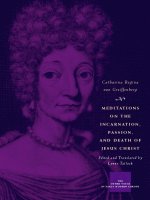In pursuit of civility manners and civization in early modern england
Bạn đang xem bản rút gọn của tài liệu. Xem và tải ngay bản đầy đủ của tài liệu tại đây (6.47 MB, 377 trang )
In
Pursuit
of
Civility
Manners and
Civilization
in Early Modern
England
Keith Thomas
Tai Lieu Chat Luong
in pursuit of
Civility
12
t h e m e nah e m st e r n j eru s al em
L e ct u r e s
Brandeis University Press
Historical Society of Israel
1 Keith thomas 2
In Pursuit
of
Civility
․․․․․․․
manners and
Civilization in early
modern england
․․․․․․․
Brandeis University Press
Waltham, Massachusetts
12
historical society of israel /
brandeis university press
An imprint of University Press of New England
www.upne.com
© 2018 Keith Thomas
All rights reserved
For permission to reproduce any of the material in this book, contact
Permissions, University Press of New England, One Court Street, Suite 250,
Lebanon NH 03766; or visit www.upne.com
The excerpt from Richard Wilbur’s translation of Molière’s The Misanthrope
is reprinted by permission of Houghton Mifflin Harcourt Publishing.
F. R. Scott’s poem “Degeneration” is reprinted by permission of
William Toye, literary executor for the estate of F. R. Scott.
Library of Congress Cataloging-in-Publication Data
available upon request
Hardcover isbn: 978-1-5126-0280-7
Paperback isbn: 978-1-5126-0281-4
Ebook isbn: 978-1-5126-0282-1
1 to 2
j oh n,
r i c ha r d,
a nd
ma de l ine
Contents
․․․․․․․
Foreword by David Katz
ix
Prefacexiii
Introduction1
1 1 2 civil behavior11
The Chronology of Manners
11
Manners and Gentility
23
Refinement
37
1 2 2 manners and the social order49
The Social Hierarchy
49
The Topography of Manners
57
The Civility of the Middling Sort
62
The Manners of the People
65
Civilizing Agents
70
Plebeian Civility
74
1 3 2 the civilized condition86
Civil Society
86
Civilized Warfare
104
A Civilized Compassion
110
Civilized Manners
121
The Fruits of Civility
127
1 4 2 the progress of civilization134
The Ascent to Civility
134
Barbarous Neighbours
153
1 5 2 exporting civility159
Confronting the Barbarians
159
Civilizing by Force
163
Inventing Race
Fighting and Enslaving
173
176
1 6 2 civilization reconsidered183
Cultural Relativism
183
Another Kind of Civility
188
The Civilizing Mission Disputed
198
The Defects of Civilization
206
Civilization Rejected
210
1 7 2 changing modes of civility219
Xenophobic Masculinity
219
Manners and Morality
223
The Quaker Challenge
230
Democratic Civility
235
The Future of Manners
247
Note on References
257
Abbreviations259
Notes261
Index349
Foreword
David S. Katz
․․․․․․․
The great Swiss historian Jacob Burckhardt prefaced his study of the civilization of the Renaissance in Italy by remarking that to “each eye, perhaps,
the outlines of a given civilization present a different picture.” The historical
sources are a “wide ocean,” and in fact “the same studies which have served
for this work might easily, in other hands, not only receive a wholly different
treatment and application, but lead also to essentially different conclusions.”
Burckhardt wrote these words, derived from his personal experience at the
coal face of historical research in the mid-nineteenth century, at a time when
the field was becoming professionalized in the Age of Ranke. Historiographical theory eventually caught up with what Burckhardt already knew. In the
1930s we were informed that it is the job of historians to recognize patterns in
the stream of past events. Fifty years later it was revealed that there is no history “out there” waiting to be transferred to the printed page. It is the historian
who chooses the subject and paints a coherent picture from the material he or
she selects. This is why Burckhardt wrote that his bulky book was merely “an
essay in the strictest sense of the word.”
For over half a century, Keith Thomas has sailed that “wide ocean” of early
modern English historical sources, alighting on scholarly islands of his own
creation: religion and the decline of magic, man and the natural world, the
ends of life, and now the concept of civility, not to mention smaller but important islets along the way. His working technique is no secret, observable
not only to regular denizens of the Upper Reading Room of the Bodleian
Library at Oxford, but also to readers of the London Review of Books, where
in a fascinating article published in 2010 he revealed how he does it (“Diary,”
London Review of Books, 10 June, 2010). Keith Thomas developed a unique
system, which begins with note taking, then cutting up the gobbets into strips
that are crammed into envelopes bearing subject titles and are finally stapled
onto pieces of paper that are stacked in a particular order, and this all before
he begins to write. The technology is old-school, and as Thomas himself comments sardonically, most of what takes him days to do can now be done by
searching a database for a key word.
But all that depends on knowing upon which wide ocean to sail. As Ranke
himself insisted, after the documents have been collected, “intuition is required.” Keith Thomas never accepted the dubious claim that fine writing is
literature and the rest is mere historical raw material ready for mining and
production. The sort of historical anthropology that he practices involves
casting the broadest possible net into that wide ocean, in an attempt to read
everything published between about 1530 and 1770. In this he is like his predecessor Christopher Hill, who introduced the method of massive “far-reading”
and made the English Civil War one of the most attractive fields of research
for scholars coming of age in the late sixties and early seventies.
It is very hard for us today to convey the excitement generated by the publication in 1971 of Keith Thomas’s Religion and the Decline of Magic. It was
his first book and he was nearly forty years old, but it was the product of
a long gestation. In those halcyon days, young scholars were not hounded
into premature publication of countable articles or pressured into applying
for unneeded outside grants. Anthropology was all the rage then, and historians were keen to apply to their work the insights of people like Claude Lévi-
S
trauss, Mary Douglas, and Clifford Geertz. The supernatural shadow cast
by conventional religion was understood, and the European witch craze of the
sixteenth and seventeenth centuries was already a subject for discussion. But
Keith Thomas’s book put it all together, not only witchcraft in its distinctive
English form, but also the place of magic— “the bastard sister of science,” as
Frazer called it— and the entire range of occult popular and elite thought
in a land where the gradual adoption of Protestantism left believers helpless
before the forces of evil, abandoned by the comforting saints and rituals of
the Roman Catholic tradition. The phenomenon of witchcraft and popular
culture in general became academic growth industries after the publication
of Keith Thomas’s massive book, which helped establish the historical study
of early modern England as perhaps the most exciting field in English history
for many years.
In Man and the Natural World: Changing Attitudes in England, 1500–1800,
published in 1983, Keith Thomas argued that there was a major shift in English attitudes toward nature in the early modern period. In the early sixteenth
century, people assumed that nature existed in order to serve humankind.
Three centuries later, a new stance had emerged, exemplified, for example, by
efforts to preserve the countryside, and to prevent cruelty to animals. Thomas
shows his hand without hesitation, proclaiming that the book is “intended
to do something to reunite the studies of history and of literature in the way
G. M. Trevelyan continually urged.” Again, it is the sheer range of sources that
is so astonishing, the product of years of self-directed reading. Keith Thomas
gave the Ford Lectures in 2000 and expanded them as The Ends of Life: Roads
x
foreword
to Fulfilment in Early Modern England, published by Oxford University Press
nine years later. His subject is a prime example of one created by wide reading
until a pattern emerges, based on the insight that although naturally everyone
hoped to find a place in the world to come, in practice people also wanted to
make something of their time on earth. Thomas looks at six roads to fulfillment in early modern England: military prowess, work, wealth, reputation,
personal relationships, and the afterlife.
Everything Keith Thomas writes inspires admiration, and so too this present book on the concept of civility, which is written in his signature serene
style and supported by an array of footnotes, an art form that is the secret love
of professional historians. “I have tried to identify just what it was that the
people of early modern England regarded as distinctive and superior about
their way of living,” Thomas explains, “in other words, what they thought it
meant to be ‘civilized.’” Others have written about civility, but the application
of Thomas’s method of blanket reading gives it much greater depth, and in
itself has provided a rich mine of source materials.
Burckhardt, in the middle of his great book, suddenly confesses to a crisis
of confidence. “No one is more conscious than the author of the defects in his
knowledge,” he admits. “Of the multitude of special works in which the subject is adequately treated, even the names are but imperfectly known to him.”
With a characteristic modesty that resembles Burckhardt’s, Keith Thomas
once explained his aim: “to immerse myself in the past until I know it well
enough for my judgment of what is or is not representative to seem acceptable
without undue epistemological debate.” A reviewer of one of Keith Thomas’s
books complained about his writing history “with the telling anecdote, the
apt witticism, and the evocative metaphor conveying the wide learning and
cultural urbanity of the author, while the reader is entertained and simultaneously informed about a whole society.” As with the Old Testament story of
Balaam, what was intended as a curse can only be seen as a blessing.
forewordxi
Preface
․․․․․․․
This book is a revised and much-expanded version of three Menahem Stern
lectures given in Jerusalem in November 2003. I thank the Israel Historical
Society for inviting me to deliver them; and I am very grateful to my hosts,
particularly the late Michael Heyd, the late Elliott Horowitz, and Yosef Kap
lan, for their kindness and hospitality. I also thank my alert and critical audience for listening so attentively and for offering many helpful comments in the
ensuing discussions. I am particularly grateful to Maayan Avineri-Rebhun for
the exceptional patience with which she has waited for the deplorably late
delivery of my manuscript.
Warm thanks are also due to my two publishers, Richard Pult of the University Press of New England and Heather McCallum of Yale University
Press, for their brisk efficiency and generous encouragement. I owe my introduction to Yale to the kindness of Ivon Asquith and Richard Fisher.
When I was invited, it was suggested that I might speak about manners
in early modern England. I was happy to do so, for this enabled me to return
to themes that I had discussed in previous lectures and seminars at British,
North American, Japanese, and Australian universities. It is a tricky topic,
however, for the word “manners” has several different meanings. Today it is
most commonly used as a term for polite social behavior. This is what the
elderly have in mind when they say of some young people that they have very
good manners, of others that they have very bad manners, and of some that
they have no manners at all. The history of manners in this sense of the word
was once regarded as a rather trivial subject, but in recent years it has come to
be recognized as one of considerable social and moral importance, fundamental, indeed, to understanding the way in which people think of themselves and
their relationship to each other. The French sociologist Pierre Bourdieu even
claimed that it is possible to infer “a whole cosmology, an ethic, a metaphysic, a
political philosophy, through injunctions as insignificant as ‘Stand up straight’
or ‘Don’t hold your knife in your left hand.’”*
Much of the credit for this enhanced valuation of the topic is due to the
German sociologist Norbert Elias (1897–1990), whose great work, On the
*Pierre Bourdieu, Outline of a Theory of Practice, trans. Richard Nice (Cambridge, 1977), 94.
Process of Civilisation, first published in Switzerland in 1939 but largely unnoticed until its reissue in 1969, followed by translations in French (1973–75)
and English (1978–82), did so much to show that the everyday conventions of
bodily comportment and social behavior are part of a larger process by which
human beings adapt themselves to the demands of living peacefully with each
other. Elias’s interpretation of the history of manners has some well-known
limitations. But it is impossible to discuss the topic without being conscious
of his looming intellectual presence. I am still embarrassed to recall that, on
the only occasion when I met this world authority on the history of table
manners, I managed to disgrace myself by carelessly knocking a jug of water
over the table we were sharing for lunch.
․․․
Since Elias’s day there has been a huge amount of writing about the history
of manners and politeness in many different parts of the world, some of it by
my former undergraduate pupils and graduate students. Outstanding among
recent studies of manners in early modern England is Anna Bryson’s monograph, From Courtesy to Civility (Oxford, 1998), a work so nuanced and assured as to deter anyone from attempting to follow in her footsteps. Valuable
material can also be found in Fenela Childs’s unpublished Oxford doctoral
thesis of 1984, “Prescriptions for Manners in English Courtesy Literature,
1690–1760.” I have learned a great deal from the fine essays contained in Civil
Histories, edited by Peter Burke, Brian Harrison, and Paul Slack (Oxford,
2000). A list of other scholars who have fruitfully explored some aspect of
the subject would run into the hundreds.
The French distinguish manières (social behavior) from moeurs (morals
and customs). But until the nineteenth century the English used the same
word for both. During the sixteenth century “manners” came to mean the conventions governing polite interaction, but long before then the term had been
employed in the much wider sense of mores, a people’s habits, morals, social
conventions, and mode of life. That was what the fourteenth-century bishop
William of Wykeham meant when he prescribed for his school at Winchester
the motto “Manners makyth man.”* For him, “manners” meant a boy’s whole
moral and educational formation, not just his behavior in polite social intercourse. The Book of Good Manners, published in 1487 and often reprinted,
was William Caxton’s translation of a treatise by the French monk Jacques
Legrand: it was a guide to virtuous living, outlining the duties appropriate to
*See Mark Griffith, “The Language and Meaning of the College Motto,” available on the New
College, Oxford, website.
xiv
prefac e
an individual’s social position, warning readers against the seven deadly sins,
and instructing them how to prepare for death and the last judgment.
It was this wider sense of the word that the eighteenth-century philosopher David Hume had in mind when he said in his essay “Of National Characters” that each nation had its peculiar set of manners. The same was true of
his younger contemporary the historian Edward Gibbon, when he devoted
part of a chapter of The Decline and Fall of the Roman Empire to “The Manners
of the Pastoral Nations.” Used in this all-embracing way, the term was very
close to what the late-Victorian anthropologist E. B. Tylor called “culture or
civilization,” which he defined as “that complex whole which includes knowledge, belief, art, morals, laws, custom, and any other capabilities and habits
acquired by man as a member of society.”
A similar ambiguity attached to the closely associated term “civility.” This,
too, could mean everyday politeness. But it was also the name for the most
desirable condition of organized human society, what would come to be called
“civilization,” the opposite of barbarism. Samuel Johnson’s Dictionary (1755)
gave both meanings: civility meant both “politeness” and “the state of being
civilized.” The new term, “civilization,” was slow to enter the English language
because the older word, “civility,” seemed to serve the purpose perfectly well.
In pursuing the broader meanings of “manners” and “civility,” as well as the
narrower ones, I have tried to identify just what it was that the people of
early modern England regarded as distinctive and superior about their way
of living, particularly by contrast with that of so-called barbarians and savages, in other words, what they thought it meant to be “civilized.” I have also
tried to show how these assumptions affected their relations with the other
peoples with whom they came into contact, and how their early colonial and
imperial activities were shaped by the ancient polarity between the “civil” and
the “barbarous.”
This is a subject that has been powerfully illuminated over the last seventy
years or so by an enormous volume of historical writing devoted to European
encounters with other peoples in the New World, Asia, Africa, and the Pacific. There has also been much distinguished work on the relations of the
English with their supposedly less-civilized neighbors, the Welsh, the Scots,
and especially the Irish. Scholarship on these subjects has continued to pour
out during the years since these lectures were delivered. My debts to previous historians are large, and I have tried to indicate them in the copious end
notes. I must particularly acknowledge the stimulus I have drawn from the
published writings of, among others, David Armitage, Robert Bartlett, Nicholas Canny, Sir Rees Davies, Sir John Elliott, John Gillingham, Margaret T.
Hodgen, Anthony Pagden, J. G. A. Pocock, Quentin Skinner, and Richard
prefac exv
Tuck. Their work has left me only too aware that in my concern to sketch the
broad outlines of my theme and to engage the interest of the general reader I
have had to pass cursorily over many complex matters which deserve a much
more nuanced treatment. Throughout, my approach is illustrative rather than
comprehensive.
As always, I owe a great deal to the enormously helpful and obliging staff in
all of the Bodleian Libraries, but especially in the Upper Reading Room, Duke
Humfrey’s Library as it used to be, and now the Weston Library. I am equally
indebted to Norma Aubertin-Potter and Gaye Morgan in the Codrington
Library. I also thank the friends and colleagues who have helped me on particular points. They include Thomas Charles-Edwards, Jeremy Coote, Cécile
Fabre, Patrick Finglass, James Hankins, Neil Kenny, Giles Mandelbrote, Jim
Sharpe, and Parker Shipton. At All Souls I have depended heavily on the skill
and readiness of two successive Fellows’ Secretaries Humaira Erfan-Ahmed
and Rachael Stephenson. I am profoundly grateful to the college for providing
me with so congenial an environment in which to work. Finally, I thank my
children, Emily Gowers and Edmund Thomas, for help, advice, and intellectual stimulus, and above all, my wife, Valerie, for her constant encouragement,
sagacious criticism, and selfless support.
All Souls College, Oxford
July 2017
xvi
prefac e
in pursuit of
Civility
12
Introduction
․․․․․․․
The epithets barbarous and civilized occur so frequently in
conversation and in books, that whoever employs his thoughts in
contemplation of the manners and history of mankind will have
occasion to consider, with some attention, both what ideas these words
are commonly meant to convey, and in what sense they ought to be
employed by the historian and moral philosopher.
12
James Dunbar, Essays on the History of Mankind
in Rude and Cultivated Ages (1780)
․․․․․․․
In later seventeenth-century England it was common for contemporaries to
refer casually to what they called “the civil world,” “the civilized part of mankind,” “the civilized nations,” or “the civilized world.”1 They did not always
identify the countries concerned. “How many do most of the civillest nations
of the world amount to?” asked the philosopher John Locke in 1690, “And who
are they?” He did not provide an answer, though he rejected the notion that
the “civillest” nations were necessarily Christian ones, and he instanced the
Chinese, “a very great and civil people.” For one of Charles II’s bishops, “the
civil world” included Babylon, Aleppo, and Japan.2
By the later eighteenth century, the orientalist William Marsden was able
to divide humanity into a single hierarchy of five classes of more or less “civilized” people, with the “refined nations of Europe” at the top, closely followed
by the Chinese, and at the bottom, the Caribs, Laplanders, and Hottentots,
who, he said, “exhibited a picture of mankind in its rudest and most humiliating aspect.” His contemporary Edmund Burke observed that “there is no
state or gradation of barbarism, and no mode of refinement which we have
not at the same instant under view: the very different civility of Europe and of
China; the barbarism of Persia and Abyssinia; the erratic manners of Tartary,
and of Arabia; the savage state of North America, and of New Zealand.”3
It was a conceptual scheme that would have a long subsequent history. As
E. B. Tylor observed in 1871: “The educated world of Europe and America
practically settles a standard by simply placing its own nations at one end of
the social series and savage tribes at the other, arranging the rest of mankind
between these limits according as they correspond more closely to savage or to
cultured life.”4 This was a view of the world that John Locke’s contemporaries
would have recognized. For them, “civilized” people were those who lived in a
“civil” or “polished” fashion, by contrast with the “uncivilized,” who were “wild,”
“barbarous,” or even “savage.”5
This way of dividing up humanity had an ancient pedigree. In the Athens of
the fifth century bc, all foreigners who did not speak Greek were labeled “barbarians” (barbaroi), persons whose speech was incomprehensible. Neutrally
descriptive at first, the word became increasingly depreciatory. Barbarians
were seen as not just linguistically handicapped, but also as deficient politically, morally, and culturally. There was no consensus about what these defects
were, though intemperance, cruelty, and submission to despotic rule were
frequently cited. The Hellenic sense of identity depended on this contrast
between the values of the Greeks and those of the barbarians. Yet different
writers stressed different attributes of the foreigner, and there was no single
concept of barbarism as such.6 Plato was one of those who thought it absurd
to bracket all non-Greeks together in this way, regardless of whether they
were ignorant Scythian nomads or highly cultivated Persians and Egyptians.
In the Hellenistic period (336–31 bc) the distinction between Greeks and
barbarians dwindled in significance. Stoic philosophers emphasized the unity
of the human race; and the scientific writer Eratosthenes (ca. 285–194 bc)
rejected the division of mankind into Greeks and barbarians, observing that
many Greeks were worthless characters and many barbarians highly civilized.7 In practice, the attitude of the Greeks to other peoples was often more
nuanced than that implied by the simple opposition of Hellene/barbarian.8
For the Romans, the barbarians were the peoples outside the frontiers of
the empire. They were often, though not invariably, seen as violent, lawless,
and notable for their brutal cruelty (feritas) and lack of humanitas, that is
to say gentleness, culture, and intellectual refinement. These barbarian attributes, particularly feritas, were put together to constitute the notion of
barbarism (barbaria), an amalgam of antisocial impulses, to which even the
civilized might succumb. In practice, the empire’s boundaries were permeable,
and “barbarous” outsiders were easily absorbed within them. But the stereotype had been established. In the fourth to sixth centuries the recurring invasions of the Western Empire by invading Germanic peoples did nothing to
dispel it, even though many of these so-called barbarians were in fact highly
Romanized.9
With the spread of Christianity and the disintegration of the old Roman
world, the concept of the barbarian became increasingly irrelevant. The threat
2
in pursuit of civilit y
posed from the mid-seventh century onward by the Arab conquests in North
Africa and the Iberian Peninsula made it even more so, for Islamic culture was
intellectually more sophisticated than that of Western Europe and could not
plausibly be regarded as “barbarous.” This was not the case with the Vikings,
whose repeated raids on the British Isles and Northern Europe between the
ninth and eleventh centuries led to their sometimes being denounced as barbarians.10 The crucial division until the seventeenth century, however, was
that between Christians and non-Christians, between “christendom and he
thennesse,” as the fourteenth-century poet Geoffrey Chaucer put it. The idea
of Christendom as a geographical area had been in circulation since the late
ninth century and was consolidated by the Crusades of 1095–1270 against
Muslim control of the Holy Places in Jerusalem.11 In Chaucer’s time the conflict with Islam was intensified by the rise of the Ottoman Turks, who would
go on to conquer the Balkans, capture Constantinople, destroy the Byzantine
Empire, and threaten to overrun Central Europe and the Mediterranean.
Yet alongside this enduring opposition of Christian and pagan, the old polarity of “civil” and “barbarous” had not been totally forgotten. The two ways
of dividing mankind were sometimes conflated, with Christians seen as civilizers and paganism equated with barbarism (the Latin word paganus meant
both pagan and rustic). In the twelfth and thirteenth centuries urbanization
and economic progress in Western Europe made it possible to contrast its
material prosperity with that of less-developed societies. The simultaneous
rediscovery of classical learning, especially the works of Aristotle, which had
long been studied by Arab scholars, meant the resurrection of Greek and
Roman concepts of barbarism and civility. Marked out by their alien languages, barbarians were once again associated with irrationality, lawlessness,
ferocity, and a low level of mental and material culture. The quintessential
barbarians now were the nomadic peoples of the Eurasian Steppes, but the
label was also attached to some Christian peoples: in the twelfth century, the
Celtic regions of the British Isles were regarded by the English as fundamentally barbarous.12
The military conflict between Christians and Muslims had always been
regarded as a Holy War between competing religions, but in the fifteenth
century Renaissance humanists drew on classical stereotypes to represent it
in more secular terms, portraying it as a contest between a civilized Western
Europe and a barbarous (immanis) Islam, despotically governed and merciless
in warfare. Civility slowly began to supersede religion as the crucial index of a
country’s diplomatic acceptability.13
In the sixteenth century, most Europeans still regarded the distinction
between Christian and non-Christian as crucial. Yet although the travelers
introdu c tion3
and protoethnographers who encountered the newly discovered worlds of
America and Asia were highly conscious of the paganism of their inhabitants,
their accounts of them were mostly written in the secular terms of barbarism
and civility.14 Confronted by a wide diversity of native American cultures,
the Spanish writers Bartolomé de Las Casas and José de Acosta created a
typology of barbarism with which to construct a hierarchical classification of
non-European peoples, ranging from those at the top who, like the Chinese,
possessed laws, rulers, cities, and the use of letters, to nomadic “savages” at the
bottom, such as the Caribs, who, it was thought, had no form of civil organization and lacked any means of communication with other peoples.15 The
criteria by which barbarism was identified changed over the centuries, and
so did the terminology employed.16 Scholars, travelers, and those with experience of other continents regarded barbarism not as an absolute condition,
but as a matter of degree. They thought in terms of a graduated hierarchy of
cultures, rather than a single, binary distinction between the “civil” and the
“barbarous.” But for many people, the basic polarity remained. It was applied
loosely and without reference to the finer distinctions offered by ethnographers and philosophers.
In seventeenth-century England, “civil” people were increasingly referred
to as “civilized.” This was a more complex term because it implied both a condition, that of being civil, and a process, that of having been brought to that
state by casting off barbarism. To “civilize” was to effect the transition from the
one condition to the other. This could happen to a people, as with the ancient
Britons, who were said to have been made civil by the Romans, or to wild
plants, which, when cultivated and improved, were described by s eventeenth-
century gardeners as “civilized.”17 By the later seventeenth century the process
of civilizing was beginning to be called “civilization.” In 1698, for example, a
writer remarked that “Europe was first beholding to Graecia for their literature and civilization”; and in 1706, Andrew Snape, fellow and later provost
of King’s College, Cambridge, described the gathering of human beings into
“societies and bodies politic” as “the civilization of mankind.”18 The lawyers
also used the term to denote the process of turning a criminal case into a civil
one.19 Initially employed to characterize the process or action of civilizing, the
term “civilization” also came to be used to mean the end product of that process, a civilized condition. It is hard to say when exactly the word acquired this
new sense. The first meaning gradually slid into the other. In his sermons of
the 1740s, for instance, Henry Piers, vicar of Bexley in Kent, came very close
to the idea of civilization as a condition rather than a process, when he spoke
of “civilization and polite behaviour” and “outward decorum, or decent civilization.”20 But only from the 1760s onward did English writers unambiguously
4
in pursuit of civilit y
describe the state of those who had been civilized as one of “civilization.”21 As
late as 1772, Samuel Johnson famously refused to admit the new word into
his Dictionary. To convey the condition of the civilized, i.e., “freedom from
barbarity,” he stuck to the older term, “civility.”22
Civility was (and is) a slippery and unstable word. Yet although it was
employed in the early modern period in a variety of senses, they all related
in one way or another to the existence of a well-ordered political community and the appropriate qualities and conduct expected of its citizens. In the
early sixteenth century, civility, like its Italian and French predecessors civiltà
and civilité, also took on the larger connotation of a nonbarbarous way of
living, what would eventually be known as “civilization.”23 “Civility” implied a
static condition, however, and lacked any suggestion of civilizing as a process.
During the sixteenth century, it also came to denote the narrower concept
of good manners, courtesy, and polite behavior— treating people with “common civility,” as the expression had it.24 It was this ambiguity that led James
Boswell to make his unsuccessful attempt to persuade Johnson to restrict his
dictionary’s definition of “civility” to “politeness” or “decency,” and to express
the state of being civilized with the new term “civilization.”25
Despite Johnson’s recalcitrance, “civility” in the later eighteenth century fell
back to its more restricted meaning of good manners and good citizenship,
whereas “civilization” came into general English usage, both as the word for
the civilizing process and also as a description of the cultural, moral, and
material condition of those who had been civilized. The word was widely
employed with unembarrassed ethnocentricity to suggest that the “civilized”
nations exemplified the most perfected state of human society, in comparison
with which other modes of living were more or less inferior, the products
of poverty, ignorance, misgovernment, or sheer incapacity. This assumption
would prove to be of crucial importance in shaping relations between Western Europeans and other peoples.
When, in the nineteenth century, the European states sought to define the
conditions on which they would admit other countries to membership of international society, they invoked a “standard of civilization” to which Asian
and African governments were required to conform if they wished to be recognized as sovereign bodies. This was an updated version of the ius gentium,
or law of nations, which had been invoked by jurists in the early modern period. Naturally, it was a standard that embodied the legal and political norms
of Western Europe. It made no allowance for alternative cultural traditions.
If other peoples failed to meet its formal criteria, international law denied
them recognition as sovereign states and permitted foreign intervention in
their domestic affairs.26
introdu c tion5
In the eyes of the European powers, this was not so much a question of
asserting their superiority as of achieving a necessary degree of reciprocity
between nations. A “civilized” government was expected to be capable of making binding contracts, conducting honest administration, protecting foreign
nationals, and adhering to the rules of international law. The Europeans were
right in thinking that these were requirements that “uncivilized” peoples were
usually unable to meet. Yet international law itself was a European creation,
and it reflected the interests of advanced commercial states. Countries lacking representative government, private property, free trade, and formal legal
rules were seen not as possessing their own distinctive form of civility, but as
“backward,” waiting to be cast into a Western mold. The Eurocentric idea of a
single standard of civilization reflected contempt for the norms of conduct in
other cultures; and the notion of Western superiority was invoked to justify
the forcible colonization or commercial exploitation of supposedly barbarous
peoples, in the name of a “civilizing mission” to export European standards of
legality and proper administration to benighted parts of the globe.
The League of Nations, set up after the First World War, purported to
consist of only “civilized” states and upheld the notion that it was their responsibility to spread civilization to the rest of the world.* Only with the
creation in 1945 of the League’s successor, the United Nations, was this formal
distinction between “civilized” and “uncivilized” states finally abandoned. In
the words of a leading jurist at the time, “Modern international law knows of
no distinction, for the purposes of recognition, between civilized and uncivilized States, or between States within and outside the international community of civilized states.”27
In early modern England, the ancient and long-enduring opposition between the “civil” and the “barbarous” was frequently invoked as a way of expressing some of the essential values of the time. Contemporary expositions
of the ideal of civility were exercises in the rhetoric of self-description. When
explorers and colonists deplored the “savagery” and “barbarism” they encountered in the non-European world, they were implicitly articulating what it was
that they valued about their own way of life. They defined themselves by elaborating on what they were not. Like the other great bogeys of post-Reformation
England, “popery” and “witchcraft,” the idea of “barbarism” embodied what
many contemporaries found repugnant and, by implication, revealed what it
was they admired. Just as theologians elaborated on the meaning of sin in
order to show what was good,28 “civilized” people needed the concept, and
*This did not prevent the League from recognizing Soviet Russia, Nazi Germany, and Fascist
Italy.
6
in pursuit of civilit y









